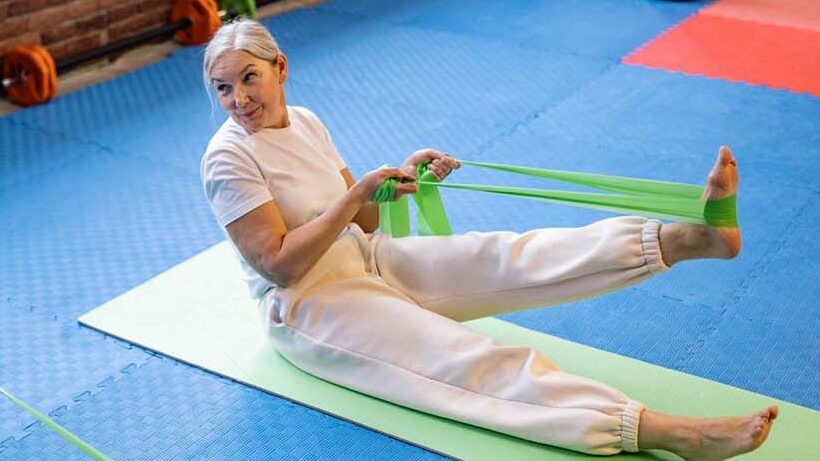Moderate intensity exercises are exercise activities that get your heart beating at a faster-than-usual pace. Moderate exercises are important because they provide regular activity at moderate levels.
Even the slightest of activity can yield great benefits – exercise prevents diseases because it helps with cardiovascular conditioning, boosts mood, and aids the maintenance of a healthy height-to-weight ratio.
What Are Moderate Intensity Exercises?
Activity in workouts is measured via metabolic equivalents. As opposed to a normal exercise routine, moderate-intensity exercises require your body to move fast enough to burn three times more energy per minute. However, just because it burns more energy as compared to a normal routine, it does not mean that they are the same as high-intensity exercises.
High-intensity exercises require intense, short-span sessions with a balanced exercise-to-work ratio, while moderate-intensity exercises require less energy with greater results.
To give you a clearer picture of how these forms of exercise are different, here are some exercise intensity values recommended by the American Heart Association;
- Moderate exercise intensity: 50% to about 70% of your maximum heart rate
- Vigorous exercise intensity: 70% to about 85% of your maximum heart rate
How To Gauge The Intensity Of Exercises?
Workout intensity can be very much relative to how your body feels while you work out. It may bring in different results, and your body can tell the difference in the level you are working out at. Here are some measuring gauges to help you identify the level of your exercise sessions if you do not use equipment – or even if you do;
- You sweat after 10 to 15 minutes of workout activity
- You can converse, but you cannot sing (because your breath quickens)
- You can feel your breath quickening, however, you do not run out of breath
These gauges can help you determine if you are going too slow or too fast. Thus helping you maintain a steady rhythm so that you do not overexert yourself.
Best Moderate Intensity Exercises For Everyone
So what are some Moderate-intensity workouts that you can do to improve your health and fitness? Here, we have prepared a list of 5 amazing exercises that you can do. And you don’t run out of breath!
You can engage in these beneficial exercises anytime, and you will see great results for sure. However, the key to reaching any goal with maximum productivity is consistency.
Cycling

Cycling is an activity for which you can set a pace you like. You can either go slow over a smooth track or add a few bumps here and there for improved exertion. (Make sure that you put in the right amount of physical exertion so that you do not run out of breath, or fall).
Cycling helps your lower body move in a repeated circular motion, while your feet and legs are constantly at work.
Cycling is also a cardiovascular workout that helps condition your heart and keeps you young (at heart) and healthy. It is one of the many versatile ways to engage in healthy movement while also having fun.
You can make cycling into a moderate-intensity exercise by first going over a smooth track and then promoting to relatively tougher terrain. Your track can contain a few bumps, a bit of an uphill ride, and turns.
So, hop on to a ride towards a healthy life.
Volleyball

You can add volleyball to your routine of workouts. This sport is not only a fun way to spend your time but also has many health benefits. Volleyball requires your body to coordinate with the movement of the ball. It engages your whole body, especially the major muscles of the upper and lower body.
With arm strength required to send the ball the opponent’s way, it tones and strengthens the muscles of your arms, shoulders, abdominals, lower legs, and thighs. Moreover, it also improves your reflexes, hand-eye coordination, and ability to maintain balance.
The benefits of this moderate exercise do not end here. Volleyball also helps improve your respiratory system while aiding cardiovascular conditioning.
Brisk Walking

Walking at an easy pace is, well, a necessity. You have to walk to even move around the house – which is not a bad thing. However, brisk walking can be added to the daily routine as a moderate-intensity workout.
Brisk walking adds a sense of purpose to your daily walk to the grocery store. It helps you reduce health risks and reap great benefits. You can improve your walking technique and turn it into a routine exercise.
Another way to go about brisk walking as a moderate-intensity exercise is to gauge the level of exertion. However, you should do so without going into realms where you are unable to breathe properly.
Iliotibial Band Stretch

The Iliotibial band is a set of fibers along the length of the upper leg, extending from the hip to the top of the shin. One of the issues that can occur in this region is the IT band syndrome, where it tightens due to overuse.
However, you can strengthen your IT band.
- Lean sideways against a wall for this if need be
- Cross your right foot in front of the left
- Raise your left arm and lean to the right, while pressing your hip out
- You will feel a stretch down your outer thigh
- Hold for 30 seconds
- Repeat for the left leg and right arm, while leaning to your left
- Do 3 reps of 20 seconds each
The Iliotibial Band Stretch helps relax the muscles along the length you focus. Make sure that you keep track of the level of exertion.
Hiking

No matter how regularly you exercise, your body and mind need to take detours into nature. Thus, go for a hike. It is also a great moderate-intensity exercise and helps your body and mind rejuvenate a great deal. Take a path that you know is easy to start with and goes uphill a bit. It is an incredible cardio workout that lowers your risk of heart disease, strengthens your core, and builds your lower body strength and endurance.
Don’t Forget To Warm-up
Your body needs to warm up before it gets going towards any physical activity. Thus, always remember to stretch your muscles. Here are a few warm-up tips for you before you move on to the 5 incredible exercises above;
- Arm circle: Stand straight with your legs slightly open. Move your hand in circles, alternatively, for 30 seconds. You can work each arm for 15 seconds. Take a rest for 10 seconds before the next exercise.
- Light Jog: Jog lightly for 30 seconds. You can do it moving across whatever venue you are using, or simply on your mat.
FAQs
What defines moderate-intensity workouts, and how do they differ from high-intensity exercises?
Moderate intensity workouts elevate heart rate and breathing while allowing conversation. They offer a balance between effort and sustainability, unlike high-intensity exercises.
Can moderate-intensity workouts aid in weight loss and overall fitness?
Yes, moderate-intensity workouts burn calories, improve cardiovascular health, and enhance endurance. Combined with a balanced diet, they contribute significantly to weight management and overall fitness.
What are some beginner-friendly moderate-intensity exercises?
Activities like brisk walking, swimming, moderate cycling, dancing, and gardening are excellent choices. They provide health benefits without overwhelming strain.

